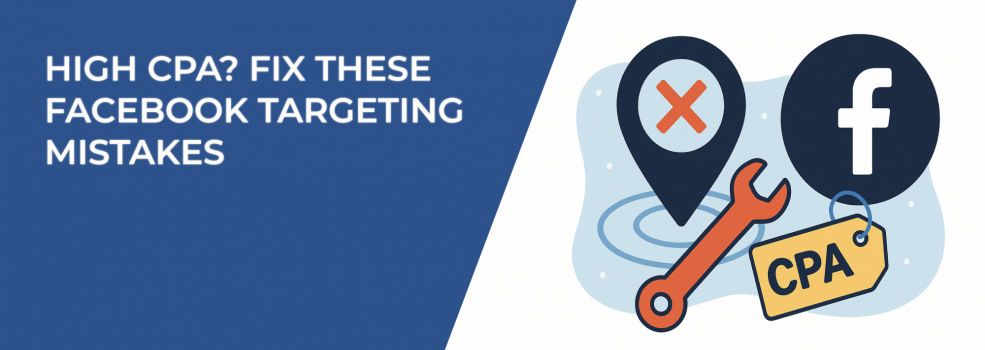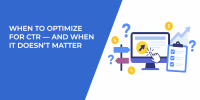If your Facebook Ads CPA (cost per acquisition) keeps climbing, you’re not alone. Many advertisers think the problem is their creative or budget, but in reality, it’s often the targeting. Small mistakes here can snowball into expensive campaigns.
The truth? Facebook targeting has become more complex in recent years. The platform relies heavily on machine learning, but algorithms are only as good as the signals you feed them. If you’re not deliberate with your targeting, you end up paying more for every single conversion.
Let’s walk through the most common — and some less obvious — targeting mistakes that quietly inflate your CPA, plus detailed fixes and examples.
1. Going Too Broad Too Fast
Broad targeting feels tempting because it promises scale, but Facebook’s algorithm doesn’t always optimize the way you expect. When you give it a wide-open audience of millions, it often starts delivering to the cheapest clicks instead of the people who are most likely to buy. That means you pay for engagement, not conversions.
Fix it:
-
Start narrower by combining two or three interest layers.
-
Use audience size filters (e.g., 500k–2M instead of 10M+).
-
Expand only once you’ve found audiences that consistently convert.
Example: Say you’re selling organic coffee subscriptions. If you just target “coffee lovers,” your ad might reach people who occasionally like coffee memes but never buy premium beans. Instead, layer it with “organic food buyers” and “online shopping behaviors.” Suddenly, your audience is smaller but much more likely to convert.
When you go broad without a strategy, your budget spreads too thin. Keeping audiences focused in the early stages gives Facebook stronger signals and improves your odds of conversions.
If you’re unsure how to balance reach and relevance, our guide on Facebook Ad Targeting 101: How to Reach the Right Audience explains how to structure targeting that keeps costs under control.
2. Ignoring Device Performance
Mobile dominates Facebook traffic — yet not all purchases happen there. Many products, especially higher-ticket items, perform better on desktop. If you let Facebook automatically distribute across all devices, you may pay for traffic that rarely converts.
Fix it:
-
Check “Breakdown by Device” in Ads Manager.
-
Shift more budget to devices that drive actual purchases, not just cheap clicks.
-
Design creatives separately for mobile and desktop instead of reusing the same ad everywhere.
Example: A B2B SaaS tool may see plenty of sign-ups from mobile users who click while scrolling, but the actual conversions (paid plans) might mostly come from desktop users. In that case, sending 70% of your budget to desktop and building desktop-friendly creatives (like product demos) can lower CPA significantly.
This way, you make sure your money goes to the places where buyers actually complete transactions — not just where they scroll.
3. Skipping Retargeting
Cold audiences are the most expensive to convert. Yet many advertisers keep throwing budget at them while ignoring warm users who’ve already shown interest. Skipping retargeting is one of the fastest ways to inflate CPA.
Fix it:
Set up retargeting campaigns for:
-
Website visitors in the last 30 days.
-
People who engaged with your Facebook/Instagram page.
-
Cart abandoners who didn’t finish checkout.
Example: Imagine running a $100 campaign to drive cold traffic to your product page. Out of 1,000 visitors, maybe 20 purchase. The other 980? If you don’t retarget them, you’ve essentially wasted that traffic. But if you retarget them with reminders, reviews, or limited-time offers, even converting 2–3% more can cut your CPA in half.
Retargeting shrinks your CPA because you’re re-engaging people who already know you. These audiences often convert faster and at a fraction of the cost compared to cold traffic.
Want a step-by-step process? Check out How to Set Up Facebook Retargeting to make sure you’re capturing those high-intent users instead of letting them slip away.
4. Relying on Weak Lookalikes
Lookalike audiences can be powerful, but only when built from strong data. Many businesses make the mistake of creating lookalikes from old or low-quality lists, which results in wasted impressions.
Fix it:
-
Use only paying customers as your seed list.
-
Test smaller lookalike ranges (1%–2%) before scaling wider.
-
Update your seed list at least every quarter.
Example: If you build a lookalike from an email list of 5,000 leads where only 200 ever converted, your lookalike will reflect mostly “window shoppers.” But if you build from 1,000 paying customers, your lookalike will reflect buyers with higher intent — cutting CPA dramatically.
Strong lookalikes mirror your best customers, not just casual subscribers. The sharper the source data, the lower your CPA will be.
5. Overlooking Geography
Not all locations are equal. Purchase intent, ad competition, and buying power vary by region. Running one campaign across multiple countries often hides big performance gaps.
Fix it:
-
Split campaigns by top-performing regions.
-
Exclude countries or cities with consistently high CPA.
-
Adjust bids based on purchase power — don’t treat every area the same.
Example: An online course provider may notice CPAs are $15 in the US but $45 in Canada. If both countries are lumped together, the algorithm averages performance and keeps spending in the expensive market. By splitting them, you can cap or pause high-cost regions and keep CPA under control.
By isolating geography, you gain control over performance. This helps you stop overspending in weak markets and double down where conversions are strong.
6. Forgetting to Exclude
Without exclusions, you’re paying for wasted impressions. That includes existing customers, job seekers, or people outside your service area. Every click from them pushes your CPA higher.
Fix it:
-
Exclude past customers from prospecting campaigns.
-
Exclude job seekers (if your ad is for a product, not recruitment).
-
Exclude age groups or demographics that don’t fit your buyer persona.
Example: A local gym running ads to “fitness enthusiasts” might attract job seekers in the industry or people living 100 miles away. By excluding employees of fitness companies and setting a 10-mile radius, the gym can stop wasting spend on irrelevant users.
Exclusions act like filters, protecting your budget from low-value clicks. The tighter they are, the more efficiently your ads run.
Exclusions can make or break campaign efficiency. Learn exactly how and when to apply them in When to Use Exclude Targeting on Facebook and Why It Matters.
7. Using Stale Interest Lists
Audiences change, competitors pile in, and trends shift. If you’ve been targeting the same interests for months, fatigue sets in. This often shows up as a slow but steady increase in CPA.
Fix it:
-
Refresh your interest targeting quarterly.
-
Test at least 2–3 new audiences each month.
-
Watch for “fatigue” — when CPA rises but CTR stays flat.
Example: If you’ve been targeting “digital marketing” interests for over a year, you may notice rising costs as competitors saturate that group. Switching to fresher or more specific interests like “email automation” or “content marketing strategy” can revitalize performance.
Fresh targeting keeps your campaigns dynamic. Updating lists helps you stay ahead of audience shifts and gives Facebook better signals.
8. Ignoring Frequency
High frequency means the same people keep seeing your ad without converting. Beyond a certain point, this annoys users and wastes money.
Fix it:
-
Cap frequency at around 3–5 for cold audiences.
-
Rotate creatives every 2–3 weeks.
-
Expand audiences when frequency gets too high.
Example: If someone sees your ad 12 times and never clicks, chances are they won’t suddenly change their mind on the 13th. At that point, you’re just burning impressions. A simple creative refresh or audience expansion can break the cycle. Managing frequency ensures your ads stay fresh. Instead of annoying users, you keep your campaigns balanced and cost-effective.
If you’re seeing rising CPAs due to ad fatigue, How Frequency Capping Helps Beat Facebook Ad Fatigue walks you through keeping ads fresh without overspending.
9. Overlapping Audiences
When two of your ad sets target nearly the same people, you compete against yourself in auctions. That drives up costs unnecessarily.
Fix it:
-
Use the Audience Overlap tool in Ads Manager.
-
Merge similar audiences into one larger ad set.
-
Let Facebook optimize within a cleaner structure.
Example: If one campaign targets “small business owners” and another targets “entrepreneurs,” there may be a 70% overlap. Instead of splitting spend and competing with yourself, combine them into one strong audience.
Cleaning up overlaps prevents wasted bidding wars. It also helps Facebook learn faster and deliver more conversions at lower costs.
10. Forgetting Purchase Intent Signals
Not every interest translates to action. Someone who “likes” a page about luxury watches might just enjoy photos, but never purchase.
Fix it:
-
Prioritize behavior-based audiences (e.g., online shoppers, page engagers).
-
Combine interests with purchase behaviors for sharper targeting.
-
Test “engaged shoppers” filters if you’re in e-commerce.
Example: A fashion brand targeting “women’s clothing” interests may reach millions of casual browsers. But by narrowing down to “engaged shoppers” or layering with “recent online purchases,” you focus on people who actually buy — not just window-shop.
By targeting intent, you stop wasting impressions on passive scrollers. Instead, you connect with people ready to take action — which is the ultimate CPA reducer.
Wrapping It Up
A high CPA doesn’t mean your ads are doomed. In most cases, it’s the result of hidden targeting mistakes: ignoring exclusions, leaning too heavily on broad or stale audiences, or failing to respect how different devices and geographies perform.
The good news? Each of these issues has a fix. Start by reviewing your campaigns against this list, trim away wasted impressions, and double down on what works.
Your ads don’t have to be expensive. They just have to be smarter.

